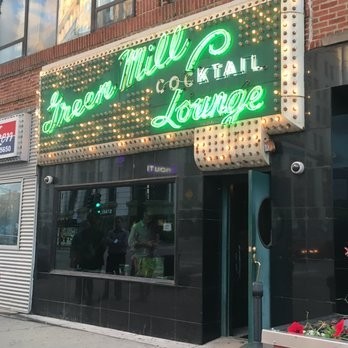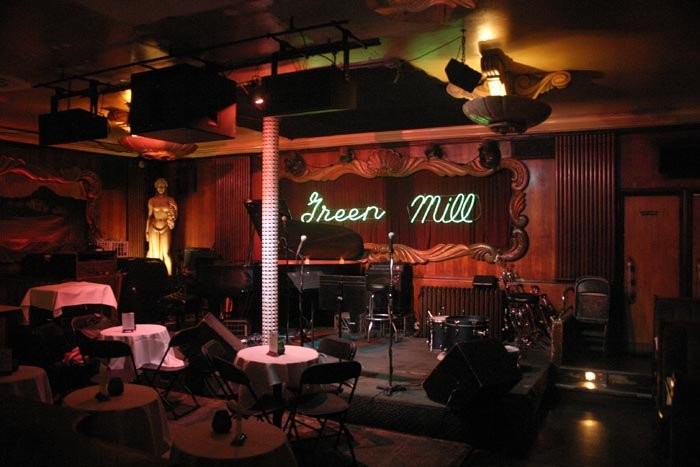Green Mill Cocktail Lounge (Green Mill Gardens)
Introduction
Text-to-speech Audio
Images
Green Mill facade and marquee sign

Green Mill updated interior

Backstory and Context
Text-to-speech Audio
During the first decade of the 1900s, the major attraction in the Uptown neighborhood of Chicago was the Graceland and Saint Boniface cemeteries. Understanding the opportunity for a business venture, a man named Pop Morse established a bar and beer garden across the street from the burial grounds. During the next three years, Pop Morse’s Roadhouse became a cornerstone of the neighborhood. Then in 1910, a real estate developer by the name of Tom Chamales purchased the establishment and renamed it the Green Mill Gardens, taking inspiration from the Parisian Moulin Rouge (Red Mill) but choosing green as a means to disassociate the bar from a local red-light district. Chamales expanded the Green Mill to encompass an entire city block and added a sunken garden and orchestra pit. The bar became something of an elite hotspot during the 1910s, with such celebrities as Charlie Chaplin becoming frequent guests. For the next decade, the Green Mill set the social precedent for the Uptown neighborhood.
Chicago during the 1920s was a pulsating city mostly due in part to the global economic stimulus, the loosening of social morals, jazz, prohibition, and organized crime. Many changes came to the Green Mill during this decade. In 1923, Balaban & Katz approached Chamales with an offer to purchase a section of the block on which the Green Mill sat for the purpose of erecting the Uptown Theatre. After that, the size of the Green Mill shrunk considerably. However, the most apparent change to the Green Mill came with the implementation of the Prohibition Act in 1920 which prohibited the sale of alcohol. Many drinking establishments, including the Green Mill, survived Prohibition by becoming jazz clubs and providing finger foods and bootlegged liquor. The Green Mill quickly became a famous mob hideout for Al Capone and his men, who used the underground tunnels to supply the venue with illegal liquors. One of Capone’s men, Jack “Machine Gun” McGurn, the likely organizer of the St. Valentine’s Day Massacre, even supposedly owned a portion of the Green Mill and essentially directed the activities of the establishment. While federal agents frequently raided the Green Mill under suspicion of selling illegal liquors, no charges were ever brought forth.
The Green Mill Garden hosted many of the famous jazz entertainers during the 1920s, such as Billie Holiday, Al Jolson, and Joseph Lewis. The mob’s influence can be understood through the assault that occurred to Joseph Lewis in 1927. Lewis was Capone’s favorite entertainer and it became known that Lewis was considering leaving the Mill for a new gig with a rival club. Lewis was shortly found in his dressing room with a slit throat and a stab to his abdomen. Surviving his assault, Lewis eventually returned to the Green Mill. It was speculated then that McGurn was behind the attack, though it was never officially determined. The Lewis attack later inspired the movie The Joker is Wildstarring Frank Sinatra.
The Green Mill reached its peak during Prohibition and sustained itself during the Great Depression; but after World War II, the club slowly fell into decline. After years of neglect and becoming an establishment of ill repute, Dave Jemilo purchased the property in 1986. Jemilo, a Chicago Southsider, began a meticulous renovation of the club and breathed new life into the old speakeasy. Today, the Green Mill is once again once of the premiere jazz clubs in America.
Sources
Flynn, Kathryn. The Green Mill in Chicago. National Trust for Historic Preservation. March 3, 2016. November 29, 2018. https://savingplaces.org/stories/the-green-mill-in-chicago#.W___Fi3MxE4.
Vavra, Sonia, Sarah Basheer, Sean Berry. Some Chicago Speakeasies Still Thriving Today. The Red Line Project. December 23, 2017. November 29, 2018. http://redlineproject.org/chicago-speakeasies.php.
Chicago Speakeasies. StoryMapJS. . November 29, 2018. https://uploads.knightlab.com/storymapjs/0284d7bd5f328b9d5ad11db01ca81abc/chicago-speakeasies/index.html.
Gentile, Jay. 8 Chicago Bars With Notorious Mob Connections. Thrillist Chicago. December 18, 2015. November 29, 2018. https://www.thrillist.com/drink/chicago/8-chicago-bars-with-notorious-mob-connections#.
